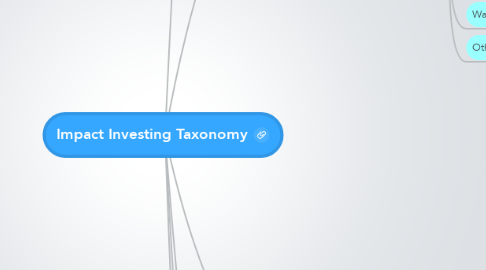
1. Types of Impact
1.1. Society Oriented
1.1.1. Social Impact
1.1.1.1. Access to services
1.1.1.1.1. Access to clean water
1.1.1.1.2. Access to energy
1.1.1.1.3. Access to financial services
1.1.1.1.4. Affordable housing
1.1.1.1.5. Access to education
1.1.1.1.6. Access to information
1.1.1.2. Economic growth
1.1.1.2.1. Agricultural productivity
1.1.1.2.2. Employment generation
1.1.1.2.3. Income/productivity growth
1.1.1.2.4. Capacity building
1.1.1.3. Risk mitigation
1.1.1.3.1. Conflict resolution
1.1.1.3.2. Disease-specific prevention and mitigation
1.1.1.3.3. Food security
1.1.1.4. Social cohesion
1.1.1.4.1. Community development
1.1.1.4.2. Equality and empowerment
1.1.1.4.3. Generate funds for charitable giving
1.1.1.4.4. Health improvement
1.1.1.4.5. Human rights protection or expansion
1.1.2. Environmental Impact
1.1.2.1. Biodiversity conservation
1.1.2.2. Energy and fuel efficiency
1.1.2.3. Natural resources conservation
1.1.2.4. Pollution prevention & waste management
1.1.2.5. Sustainable energy
1.1.2.6. Sustainable land use
1.1.2.7. Water resources management
1.2. Organization Oriented
1.2.1. Compliance with international standards
1.2.1.1. Social Policies
1.2.1.2. Governance and Ownership
1.2.1.3. Environmental Policies
1.2.2. Employment
1.2.2.1. Employees
1.2.2.2. Wages
1.2.2.3. Training and Assessment
1.2.3. Product
1.2.3.1. Quantity and Reach
1.2.3.2. Quality and Performance
1.2.4. Value Chain
1.2.4.1. Suppliers
1.2.4.2. Distributors
1.2.5. Shareholders
1.2.6. Government
2. Types of Sectors
2.1. Agriculture
2.2. Artisanal
2.3. Infrastructure
2.4. Education
2.5. Energy
2.6. Environment
2.7. Financial Services
2.8. Health
2.9. Housing Development
2.10. Information and Communication Technologies
2.11. Tourism
2.12. Culture
2.13. Supply Chain Services
2.14. Technical Assistance Services
2.15. Water
2.16. Other
3. Types of Investment Recipients
3.1. Individuals/Households
3.2. Non-profit/Non-governmental Organization
3.3. Financial Institution
3.3.1. Community Action Agency (CAA)
3.3.2. Credit Union/Cooperative
3.3.3. Loan Fund
3.3.4. Community Development Financial Institution
3.3.5. Non-Banking Financial Institution
3.3.6. Community Development Corporation (CDC)
3.3.7. Rural Bank
3.3.8. Thrift, Bank, Bank Holding Company
3.3.9. Venture Capital Fund
3.4. Non-Financial Instition (Private Sector)
3.4.1. Microenterprise (10 or fewer employees)
3.4.2. Small enterprise (11-50 employees)
3.4.3. Medium enterprise (51-250 employees)
3.4.4. Large organization (more than 251 employees)
3.5. Governmental Organization
3.5.1. National
3.5.2. Regional
3.5.3. Sub-regional
4. Types of Impact Investment Theses
4.1. Correct market failures
4.1.1. Information asymmetries
4.1.2. Non-competitive markets
4.1.3. Principal-agent problems
4.1.4. Externalities
4.1.5. Public Goods
4.2. Manage risk
4.2.1. Concessional finance
4.2.2. Reduce risk through operational improvements
4.2.2.1. ESG Compliance to reduce risk
4.2.2.2. Sector Aggregation
4.3. Subsidize private investment in underserved areas or innovative themes
5. Types of Activities
5.1. Financial Inputs
5.1.1. Mobilize investments
5.1.2. Direct Investments
5.1.2.1. Debt investments
5.1.2.2. Equity investments
5.1.3. Investments via intermediaries
5.2. Non-Financial inputs
5.2.1. Guidance and informal advice
5.2.2. Training and technical assistance
5.2.3. ESG Advisory
5.2.4. Networking and Knowledge Sharing
6. Types of Ultimate Beneficiaries
6.1. By demographic classification
6.1.1. All (i.e., not targeted)
6.1.2. Children and Adolescents
6.1.3. Disabled
6.1.4. Minority/Previously Excluded populations
6.1.5. Women
6.1.6. Other
6.2. By socioeconomic classification
6.2.1. All (i.e., not targeted)
6.2.2. Very poor
6.2.3. Poor
6.2.4. Low income
6.2.5. Other
6.2.5.1. Middle Income
6.2.5.2. Upper Income
6.3. By geographic residence
6.3.1. National geography
6.3.1.1. Region
6.3.1.1.1. Africa
6.3.1.1.2. Asia
6.3.1.1.3. Latin America
6.3.1.1.4. CEE/CIS
6.3.1.2. World Bank Income Classification
6.3.1.2.1. LIC
6.3.1.2.2. LMIC
6.3.1.2.3. UMIC
6.3.2. Sub-national geography
6.3.2.1. Rural
6.3.2.2. Urban

